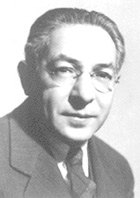Pupin Hall, Columbia University
New York, New York
Rabi and Magnetic Resonance
By Alaina G. Levine

Isidor Isaac Rabi
Isidor Isaac Rabi (1898-1988) was awarded the Nobel Prize for Physics in 1944 for developing a “resonance method for recording the magnetic properties of atomic nuclei”. His extensive research at Columbia University on investigations into the nature of the force that holds atomic nuclei together led to the creation of the molecular-beam magnetic-resonance detection method. Using this system, physicists were finally able to detect and measure magnetic moments of the nuclei. “The precise measurements yielded by this method made possible such subsequent applications as the atomic clock…and the laser, as well as the nuclear magnetic resonance imaging used in diagnostic medicine.. Rabi’s method provided the central technique for virtually all molecular and atomic beam experimentation."1
Rabi was born in Raymanov, Austria, on July 29, 1898. He graduated from Cornell University with a Bachelor’s in Chemistry in 1919, and received his Ph.D. in Physics from Columbia University in 1927. His work focused on the magnetic properties of crystals, and led him to spend two years working in Europe, collaborating at different times with some of the great scientists of the day including Arnold Sommerfeld, Niels Bohr, Wolfgang Pauli, Otto Stern, and Werner Heisenberg. On his return in 1929, Rabi was appointed lecturer in Theoretical Physics at Columbia University, and in less than 10 years, rose to the rank of full professor.
In the 1930s, physicists knew that the atomic nucleus is composed of two types of particles, positively charged protons and neutral particles called neutrons. Surrounding the nucleus is a cloud of negatively charged electrons. Physicists had discovered that electrons, protons and neutrons behave as though they are spinning about their axes. This results in a property called spin angular momentum, which generates a magnetic field and an associated “magnetic moment”, in which the particles act like tiny bar magnets with north and south poles. When placed in a strong external magnetic field, the “magnetic moment” of a nucleus tends to align with or against the external field, just as we observe ordinary bar magnets to behave. 2
Rabi predicted that the magnetic moments of nuclei could be induced to flip their magnetic orientation if they absorbed energy from an electromagnetic wave of the right frequency. They would also emit this same amount of energy in falling back to the lower energy orientation, and Rabi would be able to detect this transition from one energy state to the other. He called this method molecular beam magnetic resonance.
Rabi’s experiments involved passing a beam of lithium chloride molecules through a vacuum chamber and manipulating the beam with different magnetic fields. To provoke the magnetic moments of the nuclei to flip, he bathed the molecular beam in radio waves while varying the magnetic field strength. This use of varying radio waves was suggested by Dutch physicist Cornelius J. Gorter.3
By adjusting the external magnetic field and the radio frequency, he was in fact able to observe magnetic resonance absorption. The magnetic moment of the nuclei changed direction, and since each atom or molecule has a characteristic pattern of resonance frequencies, Rabi realized he could detect a series of resonances in different molecules that could be used to identify the type of atom or molecule and ultimately giving more detail into molecular structure.4
In 1946 Edward Purcell and Felix Bloch independently found a way to study the magnetic resonance properties of atoms and molecules in solids and liquids, instead of individual atoms or molecules as in Rabi’s molecular beam method. Later, nuclear magnetic resonance was further developed into the imaging technique that is now commonly used for medical diagnosis. The first images were produced in the early 1970s, and the first live human subject was imaged in 1977. MRI machines became commercially available in the 1980s, and are now commonly used for imaging internal body structures, especially soft tissues like the brain.
Shortly before he died in January of 1988, Rabi was imaged in an MRI machine. "It was eerie. I saw myself in that machine," he said. "I never thought my work would come to this."
While Rabi’s greatest legacy is the discovery of magnetic resonance as way to see inside and identify atoms, he is also credited with helping in the development of radar, creating the concept of CERN, the European Organization for Nuclear Research in Geneva, Switzerland (and now the world’s largest particle physics laboratory), and as one of the founders of the Brookhaven National Laboratory, in Upton, NY.5
Copyright © Alaina G. Levine, 2008.
1 "Isidor Isaac Rabi." Encyclopædia Britannica. 2008. 29 Aug. 2008. http://www.britannica.com/EBchecked/topic/487952/Isidor-Isaac-Rabi.
2 "A Life-Saving Window on the Mind and Body: The Development of Magnetic Resonance Imaging," Beyond Discovery, The National Academies.
3 Ibid.
4 "Isidor Rabi: Scientists and Citizen,” by John S. Rigden, APS News, July 1998.
5 "Isidor Isaac Rabi." Encyclopædia Britannica. 2008. Encyclopædia Britannica Online. 02 Sep. 2008.
